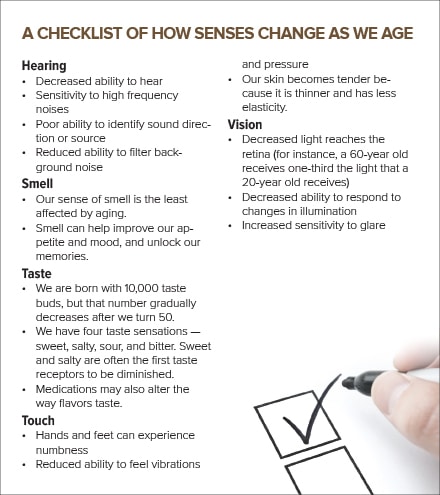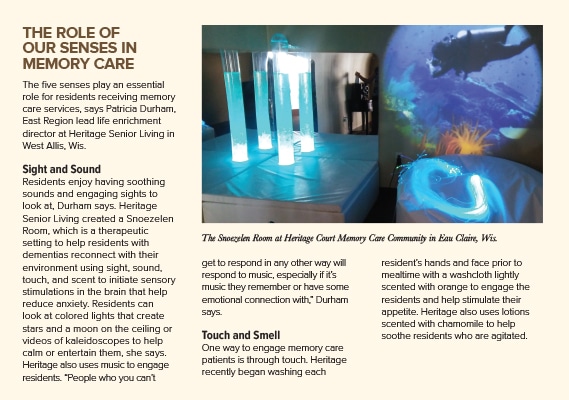As we age, we are likely to experience changes in our senses; our ability to see, hear, taste, smell, and touch may diminish or be altered. Changes to our sight include a reduced ability for our eyes to adjust to changes in light or to distinguish colors, and an increased sensitivity to glare, says Dr. John Newman, a geriatrician at the University of California at San Francisco and the Buck Institute for Research on Aging. Eye diseases like glaucoma, cataracts, and age-related macular degeneration also take a toll on our sight. As we come less sensitive to light, our day and night rhythms also may change, impacting our circadian rhythm.
Our ability to hear decreases. We become more sensitive to high frequency noises and less able to filter out background noise, says Dr. Edgar Pierluissi, medical director of the Acute Care for Elders Unit and the interim division chief for hospital medicine at San Francisco General Hospital.
Our sense of taste changes and food might not taste as good, either because of changes in our sense of smell or because we are taking medication that alters the way food tastes, giving it a metallic or bitter flavor, Newman says. Even touch can be affected by age, as our hands, fingers, and feet typically experience numbness.
Fortunately, senior living communities are finding ways to adapt their environments to help residents compensate for these changes. Here are some of the innovative ways senior living communities are using the science of aging research to better serve their residents.
Vision
To help designers understand how older residents see colors many use special glasses that mimic the yellowing of the cornea that affects our ability to distinguish colors as we age. Reds become rustier and blues look muddy, says Dean Maddalena, president of senior living community design firm studioSIX5 in Austin, Texas. “You see a blue and gray carpet and think it looks too busy but it might almost look solid to an older person,” he says.
Using contrasting colors can help residents to see better, says Keith Bradley, a designer at Levi + Wong Design Associates in Concord, Mass. For instance, it’s helpful to put a brightly colored wall behind a white toilet to help them see where the bathroom fixture is located, he says. The same is true of seating areas in a living room or dining room. “We want the seating areas to contrast against the floor surface so when someone is sitting down they can see the difference,” Maddalena says. In general, he says, you wouldn’t want to put a blue chair on a blue carpet because older residents might not be able to easily distinguish the chair from the floor because of changes in their vision.
The use of contrasting colors can also help residents to better see their food. For instance, if you serve mashed potatoes on a white plate, some residents might not see the food, says Patricia Durham, East Region lead life enrichment director at Heritage Senior Living in West Allis, Wis. Instead of white plates, Heritage uses orange and red plates that contrast with the food, she says.
Reducing glare is also important because our eyes become more sensitive to glare as we age. Windows that let in natural light are essential in senior living communities, but it’s important not to place them at the end of a long hallway, Maddalena says, because that creates a glaring light that makes it harder for residents to see and adjust their eyes in the hallway.
Light can also play a role in helping to improve a resident’s sleeping patterns. Some senior living communities are replacing overhead fluorescent lighting with adjustable light-emitting diodes (LED) to mimic the effects of sunlight. By using a bluer, brighter light in the morning, and a warmer dimmer light in the evening, lighting can help activate residents during the day and make them sleepier at night, says Andreas Wojtysiak, a biologist at OSRAM, a lighting manufacturer in Munich, Germany.
Hearing
Soft flooring, drapes, and fiberglass ceilings can help minimize background noise and help create acoustics that muffle distracting sounds that often get picked up by hearing aids and make it more difficult for older residents to follow conversations, Maddalena says. Softer surfaces on the floor, walls, and ceiling cut down on the amount of reverberation in open spaces like dining rooms and lounges and help mitigate the noise, Bradley says.
The type of flooring used can have a significant impact on acoustics, says Keith Gray, director of applied research at J+J Flooring Group in Dalton, Ga. Installing carpeting or textile composites on the floor can minimize noise. Two measureable properties to consider are the flooring’s noise reduction coefficient, which determines the amount of sound energy absorbed upon striking a particular surface, and the impact insulation class, which rates how well a floor attenuates sounds, such as footsteps, Gray says.
J+J Flooring recently partnered with The Center for Health Design to create an Impact of Aging Toolbox. This free resource, available at healthdesign.org, offers case studies and interviews about ways to minimize the impact of noise in senior living communities as well as other topics, including ways to minimize slips and falls, Gray says.
New technology also has made it easier for senior living communities to better serve residents with decreased hearing. Some communities are experimenting with induction loop hearing aids that essentially operate as wireless loudspeakers to deliver clear, customized sound to hearing aids through an electromagnetic signal. Levi + Wong is currently working with Hearthstone Alzheimer Care to design a new 120-residence senior living community and some of the personal rooms, as well as the community’s auditorium, will be fitted with this technology, Bradley says.
Taste and Smell
Our sense of taste and smell are linked and they can have a profound effect on our appetite, our mood, and our memories. “Of all our senses, the sense of smell is the one that won’t change over time,” says Roel Ventura, ambient designer at Ambius, which provides plant, décor, and scent services to senior living communities. Scent can bring us back to certain times in our lives and help us make connections to our past even when we can’t see or hear as well, he says.
Popular scents include lavender, fresh linen, cookies, and bread baking. While lavender can be calming, the smell of cookies or bread baking have been linked to helping increase appetites in older residents. A recent observational study by Consumatics and Rentokil Initial found that introducing the scent of fresh bread before and during meal times resulted in a five percent drop in malnutrition levels for residents.
The combination of environment, visually appealing meals and scent can create a multiplier effect to stimulate appetite. More communities are moving to open kitchens because the combined effect of the sight and smell of food often entices residents to eat more, Bradley says. The sight and smell of food can be an important reminder to eat, especially for residents that experience Alzheimer’s disease and dementia, he says.
Touch
As we age, our skin becomes tender and easier to damage so senior living communities want to be careful not to use furniture that has rough fabrics or sharp edges, Maddalena says. It’s also important for the furniture to have smooth finishes that are easy for residents to grasp because they often use the arms of a chair or the table to lower and lift themselves into their seat.
Some communities are using touch as a way to help residents find their way by creating textured walls that are used as landmarks, Bradley says. It’s natural for residents to touch the walls as they use the handrails so it makes sense to use texture as a landmark. “We try to do a feature wall in each room that has a different texture,” he says. This signals to the residents whether they are in the living room or the dining room or in a hallway.
Understanding the science behind how our senses change as we age is critical to designing a comfortable senior living community, Maddalena says. In fact, he predicts that designing for the five senses will become even more prominent as baby boomers age because that generation is much more in tune to the mind-body connection than previous generations.


